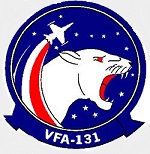Hobby Master HA3515 USN McDonnell Douglas F/A-18C Hornet Strike Fighter - Capt. Bill Gortney, CAG Bird, "Still Flying Strong," VFA-131 "Wildcats" [Low-Vis Scheme] (1:72 Scale)
"Bigger, Higher, Faster, Farther."
- Thinking within the US Air Force during the late 1970s
 The F/A-18 Hornet is the true multi-role aircraft. It can vault from a carrier deck, bomb a target and stay to dogfight even the best enemy aircraft without missing a beat. It's the Navy's first modern-era jet intended for double duty against air- and ground-based adversaries. Armed to the hilt with Sparrow and Sidewinder air-to-air missiles, an internal cannon, and laser-guided bombs, this modern warbird was an outstanding performer in Operation Desert Storm. Strapped into a digital cockpit described as a cross between Star Wars and a video game, pilots of the F/A-18 Hornet take on the ultimate aviation job: blasting this single-seat, high-performance jet off the deck of a carrier, dropping bombs, and firing air-to-ground ordnance. Offering unmatched agility, the Hornet is the choice aircraft of the US Navy's elite Blue Angels aerobatic team.
The F/A-18 Hornet is the true multi-role aircraft. It can vault from a carrier deck, bomb a target and stay to dogfight even the best enemy aircraft without missing a beat. It's the Navy's first modern-era jet intended for double duty against air- and ground-based adversaries. Armed to the hilt with Sparrow and Sidewinder air-to-air missiles, an internal cannon, and laser-guided bombs, this modern warbird was an outstanding performer in Operation Desert Storm. Strapped into a digital cockpit described as a cross between Star Wars and a video game, pilots of the F/A-18 Hornet take on the ultimate aviation job: blasting this single-seat, high-performance jet off the deck of a carrier, dropping bombs, and firing air-to-ground ordnance. Offering unmatched agility, the Hornet is the choice aircraft of the US Navy's elite Blue Angels aerobatic team.
Pictured here is a gorgeous 1:72 scale diecast replica of a USN McDonnell Douglas F/A-18C Hornet Strike Fighter that was piloted by Capt. Bill Gortney, and nicknamed "Still Flying Strong," who was attached to VFA-131 "Wildcats".
Sold Out!
Dimensions:
Wingspan: 7-1/2-inches
Length: 9-inches
Release Date: March 2013
 Historical Account: "Wildcats" - In August 1990, while embarked on USS Eisenhower (CVN-69), F/A-18 squadrons flew missions in the Red Sea in support of Operation Desert Shield, the build-up of American and Allied forces to counter a threatened invasion of Saudi Arabia by Iraq and as part of an economic blockade of Iraq to force its withdrawal from Kuwait. The Eisenhower task force was the first U.S. force in position to deter Iraqi incursion into Saudi Arabia. Upon return from deployment in September 1990, the squadron transitioned to FA-18C Lot XIII Night Strike Hornets. One year later, the squadron again deployed aboard Eisenhower to the Red Sea and North Persian Gulf in support of Operation Desert Storm.
Historical Account: "Wildcats" - In August 1990, while embarked on USS Eisenhower (CVN-69), F/A-18 squadrons flew missions in the Red Sea in support of Operation Desert Shield, the build-up of American and Allied forces to counter a threatened invasion of Saudi Arabia by Iraq and as part of an economic blockade of Iraq to force its withdrawal from Kuwait. The Eisenhower task force was the first U.S. force in position to deter Iraqi incursion into Saudi Arabia. Upon return from deployment in September 1990, the squadron transitioned to FA-18C Lot XIII Night Strike Hornets. One year later, the squadron again deployed aboard Eisenhower to the Red Sea and North Persian Gulf in support of Operation Desert Storm.
In May 1994, the squadron was part of the maiden deployment of USS George Washington (CVN-73). They flew sorties in support of Operation Deny Flight over Bosnia-Herzegovina and Operation Southern Watch over Southern Iraq. In October 1994, they returned to the Persian Gulf and participated in Operation Vigilant Warrior, in response to Iraqi aggression.
In April 1996, the Wildcats once again deployed aboard Washington to the Mediterranean, Adriatic Sea, and the Persian Gulf in support of Operation Decisive Endeavor and Operation Southern Watch. In February 1998, the squadron deployed for the Around the World, maiden deployment of USS John C. Stennis (CVN-74), again supporting Operation Southern Watch in Iraq. Upon return to the United States in December 1998, they relocated from NAS Cecil Field, Florida, to NAS Oceana in Virginia Beach, Virginia.


